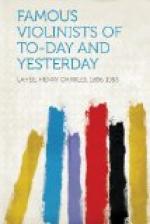after a few bars I already noticed that my accompanists
knew not the music and were quite incapable of playing
it. This disturbed me, and my dismay increased
when I observed that the assembled company paid little
attention to my playing. Conversation became
general, and ultimately so loud as almost to drown
the music. I rose in the midst of the music,
hurried to my violin case without saying a word, and
was on the point of putting my instrument away.
This made quite a sensation in the company, and the
host approached me questioningly. I met him with
the remark,—which could be heard everywhere,—’I
have always been accustomed to be listened to with
attention. As it has been otherwise here, I thought
the company would prefer that I should stop.’
The host did not know at first how to reply, and retired
somewhat discomfited. As I made preparations for
leaving, after having excused myself to the other
musicians, the host came up and said, quite amicably:
’If you could but play something else, something
more suitable to the taste and capacity of the company,
you would find them an attentive and grateful audience.’
It was clear to me before that I had chosen the wrong
music in the first instance for such a company, and
I was glad enough now to have an opportunity to change
it. So I took up my violin again and played Rode’s
E flat quartet, which the musicians already knew and
accompanied well enough. This time there was perfect
silence, and the enthusiasm for my playing increased
with each movement. At the end of the quartet
so much flattery was heaped upon me that I trotted
out my hobby-horse,—the G variations of
Rode. With this piece I made quite a sensation,
and for the remainder of the evening I was the object
of the most flattering attention.”
This little episode shows that Beethoven was not fully
appreciated, and it also shows that quartet playing
was regarded at that time in an entirely different
light from that in which we are accustomed to think
of it to-day. We do not consider the first violinist
a soloist and the rest merely his accompaniment, but
each member of the quartet is practically of equal
importance.
Lambert Joseph Massart, the eminent teacher of Paris,
is said to have been an excellent quartet player,
and often, with his wife, an admirable pianist, he
gave delightful chamber concerts.
Few violinists have been more closely associated with
quartet playing than Ferdinand David, in his way one
of the most celebrated violinists. Little is
known of his early youth except that he was born at
Hamburg in 1810, and was there at the time of the
French occupation. It has been said that he played
in a concert at ten years of age and at thirteen became
a pupil of Spohr at Cassel. He made a concert
tour with his sister, Madame Dulcken, and in 1827
entered the orchestra of the Koenigstadt Theatre at
Berlin. Here he became acquainted with Mendelssohn,
with whom he was from that time on terms of the greatest
intimacy. While in Berlin he was heard by a wealthy
musical amateur named Liphart, who lived at Dorpat,
and who maintained a private quartet. He engaged
David, who eventually married his daughter, to lead
this quartet, and for several years the young violinist
remained in Dorpat, though he found opportunity to
make some concert tours through the north of Europe.




